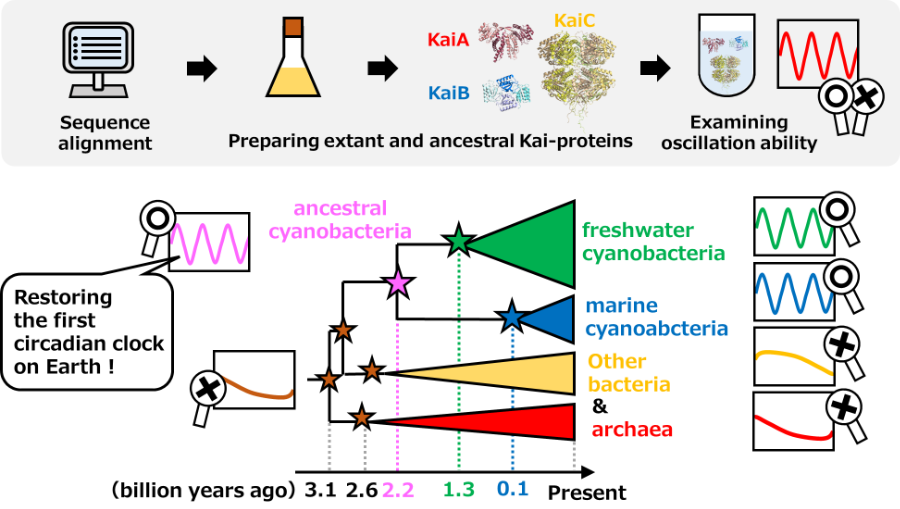The Timekeepers of Earth: Unraveling Cyanobacteria's Ancient Circadian Rhythms
A group of scientists from Japan delved into old-time timekeeping mechanisms to gain deeper insights into the internal clocks found in contemporary cyanobacteria. By examining the roles played by early versions of Kai proteins, they contrasted their functionalities with those exhibited today by KaiA, KaiB, and KaiC proteins, which manage daily rhythms within these microorganisms.

Their discoveries were published in the journal Nature Communications .
Existing cyanobacteria use a circadian clock to anticipate the daily light-and-dark cycles caused by Earth’s rotation, thereby optimising their photosynthesis processes. Our aim was to uncover the evolutionary timeline for when early bacteria first obtained the circadian clock mechanism and understand how this trait has been passed down through generations to today’s cyanobacteria. .
Atsushi Mukaiyama, an associate professor at Fukui Prefectural University,
Cyanobacteria, often referred to as blue-green algae, are photosynthesising bacteria that have greatly influenced Earth’s atmosphere and seas. Scientists believe that their most recent common ancestor emerged approximately 3 billion years ago.
The Great Oxidation Event, happening around 2.3 billion years ago when atmospheric oxygen levels rose significantly, was crucial for shaping the development of current ecological systems.
This evolution proceeded through the Neoproterozoic Oxygenation Event, where oxygen levels increased for a second time, and across at least two Snowball Earth episodes, times when our planet was largely encased in ice around 2.4 billion and 0.7 billion years ago respectively.
The Neoproterozoic Oxidation Event took place between 800 million and 540 million years ago.
By examining fossils and using molecular evolution models, scientists propose that the most recent shared ancestor of cyanobacteria had basic oxygen-producing photosynthetic mechanisms. The effectiveness of photosynthesis is notably affected by light-and-dark environmental patterns.
The research group sought to explore if early cyanobacteria possessed a timing mechanism as their ability to conduct photosynthesis kicked in during the Great Oxidization Event, which could provide understanding into the beginnings of circadian rhythm mechanisms.
Circadian clocks, which serve as internal timers controlling a creature's daily rhythm over a 24-hour period, have been observed across different species such as bacteria, fungi, plants, and mammals. The scientists concentrated their study on the circadian clock mechanism within the cyanobacteria strain. Synechococcus elongatus .
They rebuilt the clock oscillator. in vitro By utilizing the clock protein KaiC and examining the role and configuration of ancient Kai proteins, we aimed to grasp the evolutionary progression of autonomous Kai-protein oscillators.
Acknowledging that light-and-dark patterns influence photosynthetic performance in cyanobacteria, the researchers aimed to establish whether these ancient organisms possessed an intrinsic circadian rhythm during the initial stages of oxygenation when photosynthesis was initially developed.
They discovered that the ancient clock proteins contained instructions for a quicker cyclic process.
The ancient cyanobacterial clock was attuned to an 18 to 20-hour cycle. This indicates that the history of Earth’s rotational duration can be reconstructed by examining the development of these clock protein molecules. .
Yoshihiko Furuike, Associate Lecturer at the Institute for Molecular Science within Fukui Prefectural University
Based on the team's discoveries, the initial KaiC found in ancient bacteria did not possess the structural and functional attributes required for cyclical behavior.
Molecular evolution led the primordial Kai proteins to develop the necessary structure and functionality to react to the Great Oxidation and Snowball Earth events. Ultimately, this autonomous circadian rhythm mechanism was passed down to the last universal ancestor of cyanobacteria capable of performing photosynthesis.
These findings greatly contribute to scientists' understanding of chronobiology.
The aim is to create altered cyanobacteria capable of adjusting to the rotational cycles of celestial bodies beyond our planet by either decreasing or increasing the duration of the Kai-protein oscillator cycle. Although these microorganisms evolved over an extended timeframe to synchronize with a 24-hour day, contemporary understanding and technological advancements might enable us to expedite this evolutionary process significantly. .
Shuji Akiyama, Professor at the Institute for Molecular Science, Fukui Prefectural University
Institute for Molecular Science
Mukaiyama, A., et al (2025) Origins of self-sustaining Kai protein circadian rhythms in cyanobacteria from an evolutionary perspective. Nature Communications . doi.org/10.1038/s41467-025-59908-7 .

Posting Komentar untuk "The Timekeepers of Earth: Unraveling Cyanobacteria's Ancient Circadian Rhythms"
Please Leave a wise comment, Thank you